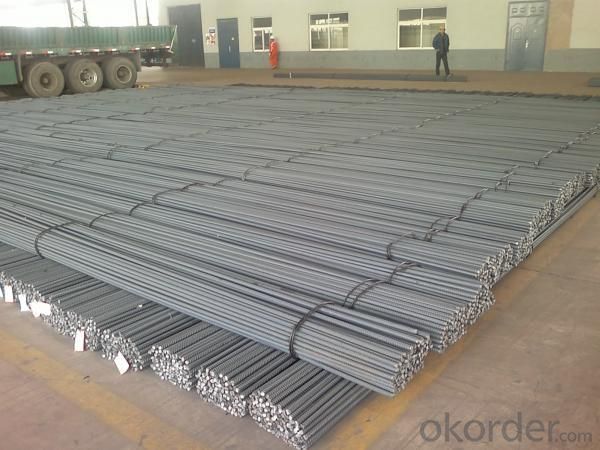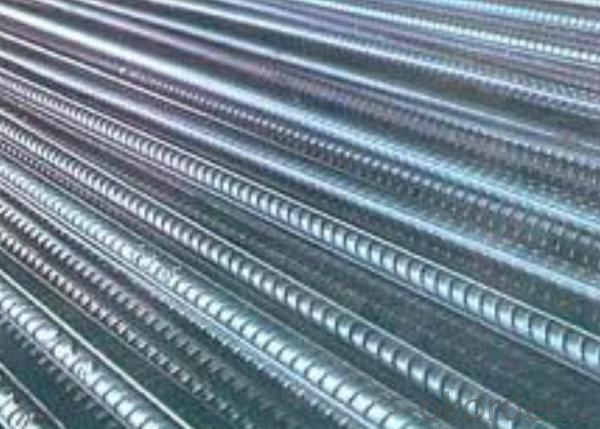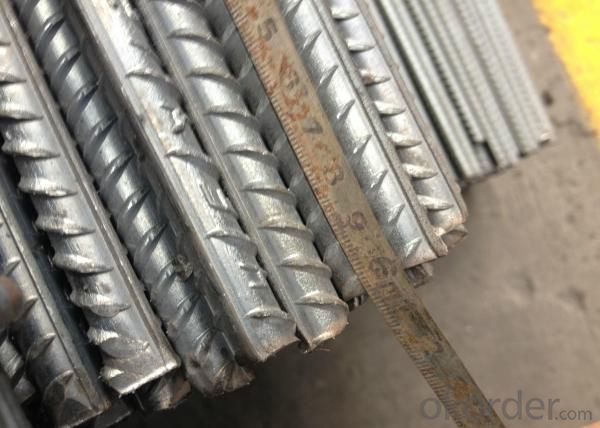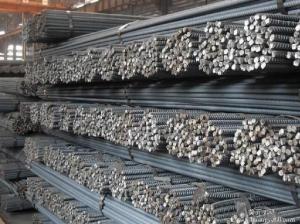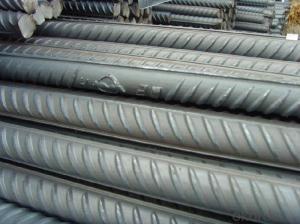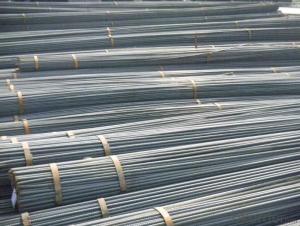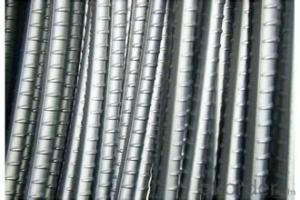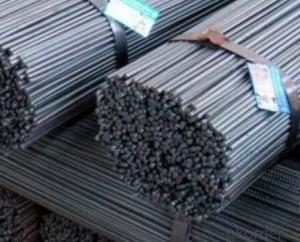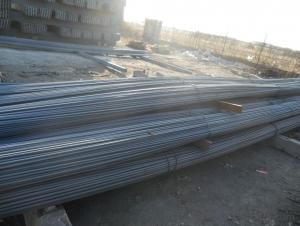Deformed Steel Bar
- Loading Port:
- China Main Port
- Payment Terms:
- TT or LC
- Min Order Qty:
- 25MT m.t.
- Supply Capability:
- 800000 MT/YEAR m.t./month
OKorder Service Pledge
OKorder Financial Service
You Might Also Like
Specifications of Deformed Steel Bar:
Standard | GB | HRB335, HRB400, HRB500 | |
UK | G460B, B500A, B500B,B500C | ||
USA | GR40, GR60 | ||
Diameter | 6mm,8mm,10mm,12mm,14mm,16mm,18mm,20mm, 22mm,25mm,28mm,32mm,36mm,40mm,50mm | ||
Length | 6M, 9M,12M or as required | ||
Place of origin | Hebei, China mainland | ||
Application | building,construction,road,bridge etc | ||
Brand name | DRAGON | ||
Theoretical weight and section area of each diameter as below for your information:
Diameter(mm) | Section area (mm²) | Mass(kg/m) |
6 | 28.27 | 0.222 |
8 | 50.27 | 0.395 |
10 | 78.54 | 0.617 |
12 | 113.1 | 0.888 |
14 | 153.9 | 1.21 |
16 | 201.1 | 1.58 |
18 | 254.5 | 2.00 |
20 | 314.2 | 2.47 |
22 | 380.1 | 2.98 |
25 | 490.9 | 3.85 |
28 | 615.8 | 4.83 |
32 | 804.2 | 6.31 |
36 | 1018 | 7.99 |
40 | 1257 | 9.87 |
50 | 1964 | 15.42 |
Usage and Applications of Deformed Steel Bar:
Deformed bar is widely used in buildings, bridges, roads and other engineering construction. Big to highways, railways, bridges, culverts, tunnels, public facilities such as flood control, dam, small to housing construction, beam, column, wall and the foundation of the plate, deformed bar is an integral structure material. With the development of world economy and the vigorous development of infrastructure construction, real estate, the demand for deformed bar will be larger and larger..
Packaging & Delivery of Deformed Steel Bar:
Packaging Detail: products are packed in bundle and then shipped by container or bulk vessel, deformed bar is usually naked strapping delivery, when storing, please pay attention to moisture proof. The performance of rust will produce adverse effect.
Each bundle weight: 2-3MT, or as required
Payment term: TT or L/C
Delivery Detail: within 45 days after received advanced payment or LC.
Label: to be specified by customer, generally, each bundle has 1-2 labels
Trade terms: FOB, CFR, CIF
Deformed Steel Bar in Coil

Produce Line of Deformed Steel Bar
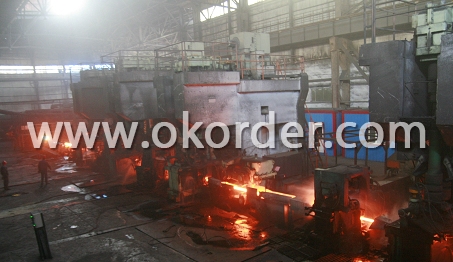
Note:
1. Our products are produced according to national standard (GB), if not, supply according to national standards (GB) or agreement as customer required.
2. Other Grade and Standard Deformed Steel Bar we can supply:
Grade: GR40/GR60, G460B/B500A/B500B/B500C,BST500S
Standard: ASTM, BS, DIN
The Minimum Order Quantity of these products is high, and need to be confirmed.
3. We can not only supply Deformed Steel Bar; if you need anything about building materials, please contact us for further information.
4. Please send us your detail specifications when inquire. We will reply to you as soon as possible. We sincerely hope we can establish a long stable business relationship.
- Q: What is the standard diameter of steel rebars?
- Steel rebars usually have a standard diameter that falls between 6 millimeters and 50 millimeters. The most frequently used diameters are 10 millimeters, 12 millimeters, 16 millimeters, and 20 millimeters. The choice of a particular diameter for a steel rebar depends on the specific application and the structural demands of the construction project. These rebars are commonly employed in reinforced concrete structures to bolster their tensile strength and overall endurance.
- Q: How are steel rebars used in the construction of power plants?
- Steel rebars are commonly used in the construction of power plants due to their strength and durability. These reinforced steel bars are used to provide structural support and reinforcement to various concrete elements in the power plant construction. One of the primary applications of steel rebars in power plant construction is in the construction of foundations and structural members. Power plants require strong and stable foundations to support the heavy equipment and machinery, as well as withstand the dynamic loads and vibrations. Steel rebars are embedded within the concrete foundation to enhance its structural integrity and resistance to compressive and tensile forces. In addition to foundations, steel rebars are also used in the construction of walls, columns, and beams in power plants. These elements play a crucial role in supporting the overall structure and ensuring its stability. By adding steel rebars to the concrete mix, the resulting reinforced concrete components can bear higher loads and resist cracking or deformation under stress. Furthermore, steel rebars are utilized in the construction of containment structures in nuclear power plants. These structures are designed to confine any potential release of radioactive materials in case of accidents or incidents. By incorporating steel rebars into the concrete walls and floors of these containment structures, their strength and resistance to impact and penetration are significantly enhanced, thereby improving the safety and security of the power plant. Overall, steel rebars play a vital role in the construction of power plants by providing reinforcement to concrete elements and ensuring the structural integrity and longevity of the facility. Their use enhances the strength, durability, and safety of the power plant, making it capable of withstanding various operational and environmental conditions.
- Q: Can steel rebars be used in tunnels and underground structures?
- Yes, steel rebars can be used in tunnels and underground structures. Rebars are commonly used in construction projects to reinforce concrete structures and provide additional strength and durability. In tunnels and underground structures, where stability and load-bearing capacity are crucial, steel rebars are often incorporated into the concrete walls, floors, and ceilings to enhance their structural integrity. The rebars help to distribute the load and resist potential cracks or deformations caused by the pressure from the surrounding soil or water. Moreover, steel rebars offer resistance against corrosion, making them suitable for underground environments where moisture and other corrosive elements may be present. Overall, steel rebars are an essential component in the construction of tunnels and underground structures, ensuring their safety and longevity.
- Q: Can steel rebars be used in parking structures?
- Yes, steel rebars can be used in parking structures. Steel rebars are commonly used as reinforcement in concrete structures, including parking structures, to provide added strength and durability. They help to increase the load-bearing capacity and resistance to cracking or bending, making them suitable for use in parking structures where heavy vehicles and constant traffic are expected.
- Q: What is the impact of steel rebars on the overall maintenance of a building?
- Steel rebars have a significant impact on the overall maintenance of a building. These reinforcement bars provide structural strength and stability by enhancing the tensile strength of concrete. By preventing cracks and minimizing structural damage, steel rebars reduce the need for frequent repairs and maintenance. Additionally, their corrosion resistance properties enhance the longevity of the building, reducing maintenance costs and ensuring its structural integrity in the long run.
- Q: What is the process of joining steel rebars together?
- Rebar splicing or rebar connection is a common practice in reinforcing concrete structures to ensure their strength and integrity. Joining steel rebars can be achieved through various methods, each with its own advantages and suitability based on project requirements. Here are some frequently used techniques: 1. Lap Splicing: This traditional and widely adopted method involves overlapping two rebars and securing them together using wire or steel tie bars. The length of the overlap is typically determined by engineering codes and standards. 2. Mechanical Splicing: A more reliable and efficient option, mechanical splicing employs specially designed couplers or connectors to join rebars. These couplers, often threaded or tapered, allow the rebars to be screwed or wedged into the connector. 3. Welding: In certain situations, rebars can be joined through welding. This technique entails heating the rebars to their melting point and fusing them together using an electric arc. Welded splices are commonly used in large-scale construction projects that require high strength and durability. 4. Compression Splicing: Compression splicing involves using compression fittings or sleeves to join rebars. The rebars are inserted into the sleeves, and a hydraulic press is utilized to compress the fitting, creating a strong connection. Compression splicing is particularly advantageous when dealing with rebars of different sizes or in areas with limited space for lap splicing. Determining the appropriate method for joining steel rebars relies on factors such as structural design, load requirements, and construction constraints. It is crucial to consult with structural engineers and adhere to local building codes and regulations to ensure the proper and safe execution of the rebar splicing process.
- Q: Can steel rebars be used in architectural detailing?
- Indeed, architectural detailing is an arena where steel rebars find extensive application. They serve the purpose of reinforcing concrete structures, thereby imparting them with enhanced robustness and stability. Furthermore, in the realm of architectural detailing, rebars are ingeniously integrated into the design to augment the structural integrity of the edifice or to fashion exquisite and elaborate patterns. The pliability of rebars allows for their bending, shaping, and positioning in diverse arrangements, thus enabling the achievement of desired architectural aesthetics. Moreover, the qualities of durability, corrosion resistance, and easy accessibility make steel rebars a favored selection in the realm of architectural detailing.
- Q: What are the disadvantages of using steel rebars?
- One disadvantage of using steel rebars is their susceptibility to corrosion. Over time, exposure to moisture and chemicals can cause the rebars to rust, weaken, and compromise the structural integrity of the reinforced concrete. Additionally, steel rebars are heavy and difficult to handle, which can increase labor and construction costs. Lastly, steel rebars are a finite resource, and their production contributes to environmental pollution and depletion of natural resources.
- Q: What is the role of steel rebars in preventing concrete creep?
- The role of steel rebars in preventing concrete creep is crucial. Concrete creep refers to the gradual deformation or movement of concrete over time under sustained load. This phenomenon occurs due to the long-term stress on the concrete, causing it to slowly deform and creep. Steel rebars, which are reinforced steel bars, are used in concrete structures to counteract this creep behavior. They play a significant role in preventing concrete creep by providing tensile strength and reinforcing the structure. When concrete is subjected to a load, it experiences both compressive and tensile forces. While concrete is excellent at withstanding compressive forces, it is relatively weak in tension. This is where steel rebars come into play. By placing steel rebars within the concrete, the tensile strength of the structure is significantly enhanced. Steel has high tensile strength, making it ideal for bearing the tension experienced by the concrete. When the concrete begins to creep under a sustained load, the steel rebars resist the deformation and distribute the tensile forces throughout the structure. The presence of steel rebars helps to restrain the concrete from excessive deformation, reducing the potential for long-term creep. By reinforcing the concrete with steel rebars, the structure becomes more resistant to creep and maintains its stability and integrity over time. Moreover, steel rebars also enhance the overall durability and structural performance of the concrete. They improve the load-bearing capacity, prevent cracking, and enhance the resistance against external forces such as earthquakes or environmental factors. In conclusion, steel rebars play a vital role in preventing concrete creep by providing tensile strength and reinforcing the structure. They resist the deformation of the concrete under sustained load, ensuring its stability and long-term integrity. The use of steel rebars significantly enhances the durability and structural performance of concrete structures, making them more resistant to creep and other potential issues.
- Q: How do steel rebars affect the overall constructability of concrete structures?
- Steel rebars play a crucial role in enhancing the constructability of concrete structures. These reinforcing bars provide strength and stability to the concrete, increasing its load-bearing capacity and resistance to tension and bending forces. By reinforcing the concrete, rebars ensure that the structure can withstand the applied loads and prevent cracking or failure. Additionally, rebars help to control the formation and propagation of cracks, improving the overall durability and lifespan of the concrete structure.
1. Manufacturer Overview
| Location | Hebei, China |
| Year Established | 2002 |
| Annual Output Value | Above US$ 400 Million |
| Main Markets | South Asia; Middle East;Southeast Aisa |
| Company Certifications |
2. Manufacturer Certificates
| a) Certification Name | |
| Range | |
| Reference | |
| Validity Period |
3. Manufacturer Capability
| a) Trade Capacity | |
| Nearest Port | Tianjin |
| Export Percentage | 60%-80% |
| No.of Employees in Trade Department | 11-20 People |
| Language Spoken: | English; Chinese |
| b) Factory Information | |
| Factory Size: | Above 100,000 square meters |
| No. of Production Lines | 2 |
| Contract Manufacturing | OEM service offered |
| Product Price Range | average |
Send your message to us
Deformed Steel Bar
- Loading Port:
- China Main Port
- Payment Terms:
- TT or LC
- Min Order Qty:
- 25MT m.t.
- Supply Capability:
- 800000 MT/YEAR m.t./month
OKorder Service Pledge
OKorder Financial Service
Similar products
Hot products
Hot Searches
Related keywords



